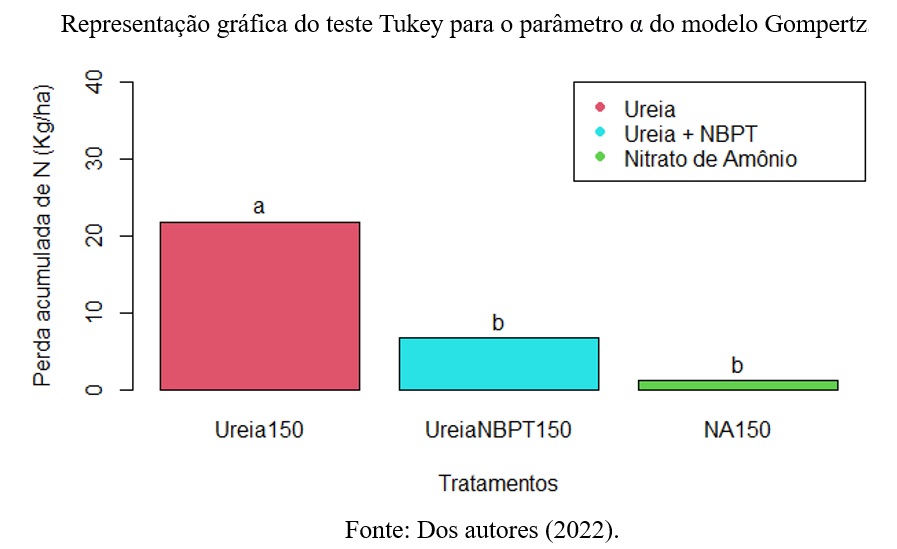Comparison of nitrogen loss in fertilizers applied to coffee plants using Gompertz model estimates
Keywords:
Analysis of Variance, Regression, Nitrogen loss, Urea, Stabilized fertilizersAbstract
The increase in coffee productivity is related to many factors, mainly the management of soil fertility. Nitrogen (N) is among the nutrients most demanded by the coffee and the conventional nitrogen fertilizer most used to suppress this demand is urea. However, urea has a large loss of N, mainly due to ammonia volatilization. With the aim of reducing the losses of conventional fertilizers and improving their use, researchers have developed innovations such as stabilized nitrogen fertilizers, resulting in the need to compare N losses in each one of them. The nonlinear Gompertz model is commonly used to describe the sigmoidal pattern, characteristic of the accumulated loss of N by ammonia volatilization. Thus, the objective of this study is to compare the accumulated loss of N from the nitrogen fertilizers urea, urea + NBPT and Ammonium Nitrate applied to coffee plants based on the parameters of the nonlinear Gompertz model. Comparison between treatments was performed using the method proposed by Carvalho et al. (2010), the Gompertz model was adjusted to each of the repetitions of the experiment, the analysis of variance was performed for each of the parameters, the F test was significant in all cases, so the Tukey test was applied. The analyzes were carried out in the R software at the 1% probability level. The conventional nitrogen fertilizer urea showed the highest accumulated loss of N in the coffee tree, whereas the stabilized nitrogen fertilizers urea + NBPT and ammonium nitrate did not show significant differences between them.
References
BANZATTO, D.A.; KRONKA, S.N. Experimentação agrícola. 4ª ed. Jaboticabal: FUNEP, 2006. 237p.
CARVALHO, L. R. et al. Methods to verify parameter equality in nonlinear regression models. Ciência Agrícola, v.67, n.2, p.218-222, 2010.
CHAGAS, W. F. T. et al. Ammonia volatilization from blends with stabilized and controlled-released urea in the coffee system. Ciência e Agrotecnologia, v. 40, n. 5, p. 497–509, 2016.
CONSELHO DOS EXPORTADORES DE CAFÉ DO BRASIL (CECAFE). Estatísticas: ago. de 2021. Disponível em: https://www.cecafe.com.br/publicacoes/relatorio-de-exportacoes/. Acesso em: 25 de ago. de 2022.
CONSELHO NACIONAL DO CAFÉ. Estatísticas: ago. de 2022. Acesso em: 18 ago. 2022. Disponível em: https://cncafe.com.br/brasil-a-nacao-do-cafe/.
DRAPER, N. R.; SMITH, H. Applied regression analysis. 3. ed. New York: John Wiley & Sons,1998. 706 p.
EMBRAPA, Café. Produção mundial de café no ano cafeeiro 2019-2020 está estimada em 169,34 milhões de sacas de 60kg. 2020. Disponível em: https://www.embrapa.br/busca-de-noticias/-/noticia/56523064/producao-mundial-de-cafe-no-ano-cafeeiro-2019-2020-esta-estimada-em-16934-milhoes-de-sacas-de-60kg. Acesso em: 26 ago. 2022.
FRÜHAUF, A.C. et al. Nonlinear models in the study of the cedar diametric growth in a seasonally dry tropical forest. Revista Brasileira de Ciências Agrárias, v. 15, p. 1-8, 2020.
GUELFI, D. Fertilizantes nitrogenados estabilizados, de liberação lenta ou controlada. Informações Agronômicas, Canadá, n. 157, p. 1-14, mar. de 2017.
JANE, S. A.; FERNANDES, F. A.; SILVA, E. M.; MUNIZ, J. A.; FERNANDES, T.J.; PIMENTEL, G. V. Adjusting the growth curve of sugarcane varieties using nonlinear models. Ciência Rural, v. 50, p. e20190408, 2020.
LARA CABEZAS, W. A. R. et al. Calibration of a semi-open static collector for determination of ammonia volatilization from nitrogen fertilizers. Communications in Soil Science and Plant Analysis, New York, v. 30, n. 3/4, p. 389-406, 1999.
MESQUITA, C. M. de et al. Manual do café: manejo de cafezais em produção. Belo Horizonte: EMATER-MG, 2016.
MIRANDA, L. F. et al. Modelos não lineares na descrição do crescimento de tilápia do Nilo criada em tanques-rede. Sigmae, v. 8, p. 606-611, 2019.
MISCHAN, M. M.; PINHO, S. Z. Modelos não lineares: funções assintóticas de crescimento. São Paulo: Cultura Acadêmica, 2014. 184p.
SEBER, G. A. F.; WILD, C. J. Nonlinear regression. New Jersey: J. Wiley& Sons, Inc. Hoboken, 2003.
SILVA, É. M. et al. Evaluation of the critical points of the most adequate nonlinear model in adjusting growth data of ‘green dwarf’ coconut fruits. Revista Brasileira de Fruticultura, v. 43, p. 01, 2021.
SOUZA, T. L. Fertilizantes nitrogenados convencionais e estabilizados na cafeicultura: análises agronômicas, de qualidade, ambientais econômica. 2019. 152 p. Tese (Doutorado em Ciência do Solo) - Universidade Federal de Lavras, Lavras, 2019.
PEREIRA, A. A.; FERNANDES, T. J; SCALCO, M. S.; DE MORAIS, A. R. Modelagem não linear do crescimento em altura do cafeeiro irrigado e não irrigado em diferentes densidades. Irriga. Unesp: Botucatu, v. 1, p. 140-149, 2016.
RODRIGUES, J. O. et al. Demanda nutricional. Revista Cultivar, Pelotas, n. 158, p. 16 -17, jun. de 2012.
TEIXEIRA, G. L. et al. Growth curves of campolina horses using nonlinear models. Livestock Science, v. 251, p. 104631, 2021.
TRENKEL, M. E. Slow- and controlled-release and stabilized fertilizers: an option for enhancing nutrient use efficiency in agriculture. Paris: International Fertilizer Industry Association, 2010.

Downloads
Published
How to Cite
Issue
Section
License
Proposta de Política para Periódicos de Acesso Livre
Autores que publicam nesta revista concordam com os seguintes termos:
- Autores mantém os direitos autorais e concedem à revista o direito de primeira publicação, com o trabalho simultaneamente licenciado sob a Licença Creative Commons Attribution que permite o compartilhamento do trabalho com reconhecimento da autoria e publicação inicial nesta revista.
- Autores têm autorização para assumir contratos adicionais separadamente, para distribuição não-exclusiva da versão do trabalho publicada nesta revista (ex.: publicar em repositório institucional ou como capítulo de livro), com reconhecimento de autoria e publicação inicial nesta revista.
- Autores têm permissão e são estimulados a publicar e distribuir seu trabalho online (ex.: em repositórios institucionais ou na sua página pessoal) a qualquer ponto antes ou durante o processo editorial, já que isso pode gerar alterações produtivas, bem como aumentar o impacto e a citação do trabalho publicado (Veja O Efeito do Acesso Livre).
